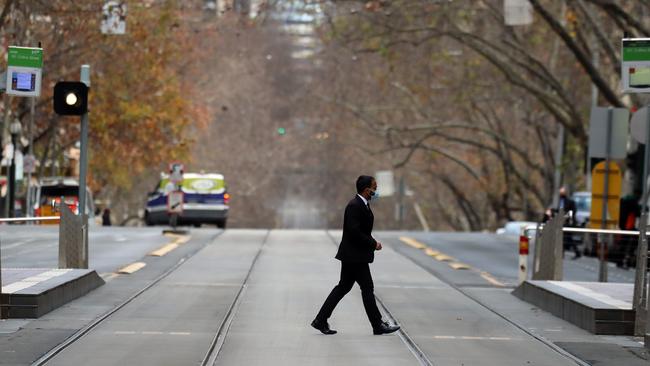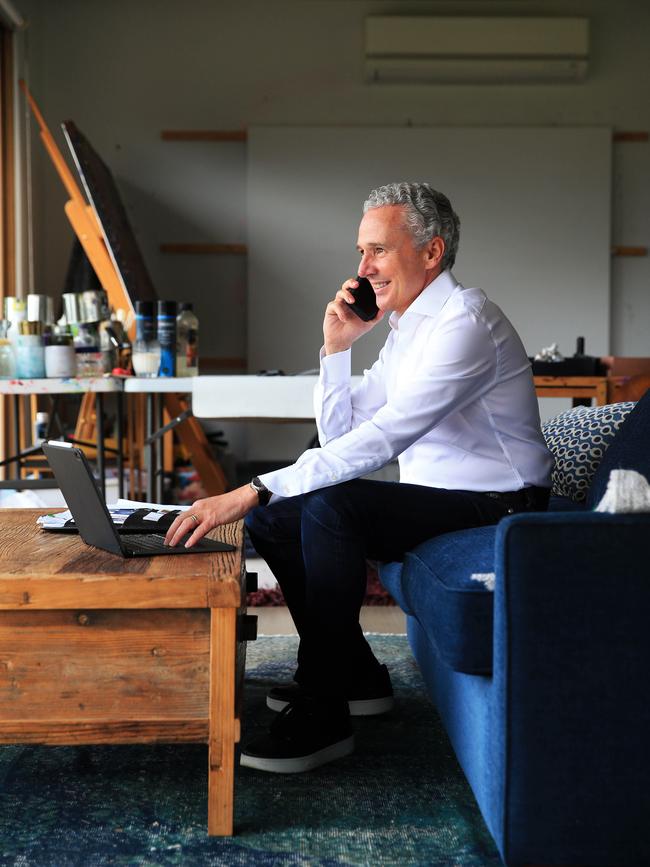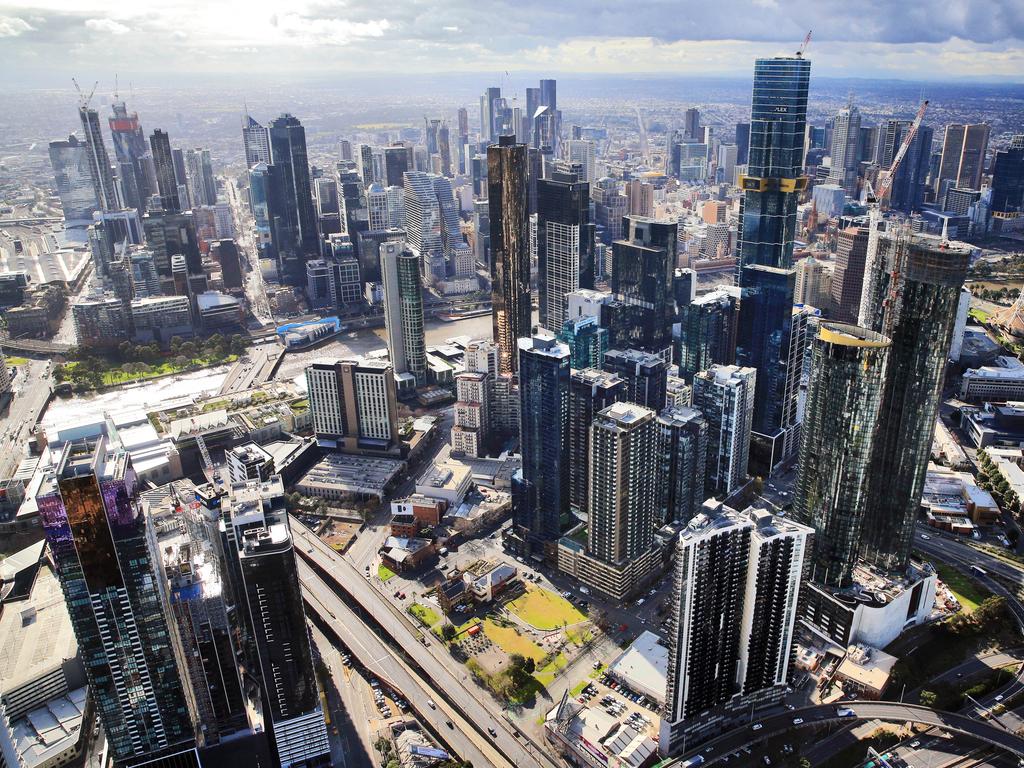Rethinking the workplace beyond Covid
Most CEOs say three days in the office will be the norm for staff, but all are wary of the impact of working from home.

Jet lag is now a distant memory for a string of formerly globetrotting chief executives. But working in a virtual world has done nothing to recalibrate some body clocks.
“I can easily do 12 hours a day, mostly on video conferences,” Telstra chief executive Andy Penn says. “It is intensive and draining.”
And those are just the daylight hours.
“I remember recently going to bed at 9pm and setting the alarm for 12.30am to get up for a call with Microsoft,” Penn says. “It was a CEO forum for 100 people around the world on Microsoft Teams, chaired by their CEO Satya Nadella, and they had Bill Gates and (BlackRock chairman) Larry Fink doing a session. Then I went to bed at 3am and set the alarm for 5.30am for a 6am Telstra board meeting for our directors spread across the globe. So the virtual working world is playing a bit of havoc with my sleep patterns.”
Before the COVID-19 pandemic Penn split travel from his Melbourne home evenly between international and regional trips and tours of duty in Sydney. He predicts some of the latter will become a thing of the past in the new virtual working world, which has been rapidly embraced by the nation’s biggest companies during the past months.
“My expectation at the moment, and it is only an expectation because we aren’t yet through this, is that I would work one day a week from home post COVID,” Penn says.
The phenomenon of working from home has implications for national productivity, CBD property and the mental health of the workforce. Interviews by The Weekend Australian with chief executives and other senior leaders from 10 of the nation’s top companies and professional services firms found most believe three days in the office is likely to become the norm for staff.
More will be empowered to live and work in regional areas as — somewhat surprisingly — the chief executives believe productivity in a virtual workplace is as good or better than the traditional office.
“I hear lots of stories about how people have responded and stepped up. I would say trust has actually been improved across the organisation rather than diminished. People can see I don’t need to have this person with me eight hours a day, five days a week,” TAL Australia chief executive Brett Clark says.

At AustralianSuper, chief executive Ian Silk says the firm’s staff engagement score has increased by 10 percentage points during the lockdown. “We have never had any movement approaching that,’’ he says of his Melbourne-based workforce, who have been working from home since the end of March.
NBN Co chief executive Stephen Rue says the same scores in his group have risen from 79 per cent to 86 per cent since April. Forty-four per cent of NBN staff say they want to work two or three days a week at home in the future. “The staff said they wanted a hybrid model where they can go into the office to collaborate, but wanted the flexibility to work from home when they could for work-life balance,” Rue says.
He won’t commit to a firm number for the future but is clear: “I do not think we will go back to where we were before COVID. We have broken a lot of hierarchies down through this period. Perhaps because we have had to make quick decisions, and being on Microsoft Teams has enabled more people to be in meetings. We are hearing more from people in the organisation. Someone at lower levels can have their views more heard during this time.”
That trend is even more pronounced in the legal profession.
“The profession was a reasonably conservative, hierarchical industry before COVID. The pandemic has catapulted the change — it has slingshot us into the future,” says Ashurst global managing partner Paul Jenkins, who runs his firms’s 28 offices in 16 countries from his Sydney base.
“For our staff working from home there has been this new ability to have greater empowerment and choice over their working lives, the freedom to design working around their life rather than vice-versa,” he says. “There have been opportunities to get more authentic connections that they had not usually had in the office. Breaking down the hierarchy and formal roles. Feeling like they are on a level playing field and every voice matters. And breaking down geographies.”
Ashurst is moving to a model where staff will be required in the office three days a week to facilitate what Jenkins calls “collision contacts”, where people have spontaneous discussions that can lead to positive outcomes for clients. “We are moving to a hybrid model and I think three days a week giving that flexibility, autonomy and choice is right to maintain that level of connectedness,” he says.
TAL’s Clark says he believes a good culture is nurtured when people are with people, “not sitting 100 per cent of the time behind a laptop on a Zoom call”. He says there will be more working from home in a post COVID-world but leaders will need to be visible in the workplace.
“I would expect leaders would do at least three days in the office,” he says. “I am now back two or three days a week and I am enjoying that. I like the buzz of being back and talking to people. And I think the staff enjoy the spontaneity of working with people again. Working from home, your conversations and days become more structured. What I have come to appreciate is the beauty of having less structure.”

KPMG is in discussions with staff about creating three hubs for the future: a client hub, a home hub and an office hub. “We are not going to be prescriptive,” chief executive Gary Wingrove says. “But it is important people spend some time in the office. If you had people spending all their time at home over a long period of time, you would lose that culture and glue. That is important in terms of the way people learn and the way our teams work. You are better off having three or four brains looking at an issue than one.”
Silk says he believes 90 per cent of staff will want to work more from home than in the past.
“When we have had people who wanted to work from home in the past, they have had a bilateral discussion with their manager and worked something out,” he says.
“Now the organisation needs to have a view on this. Are we happy not to have anyone in the office on Mondays and Friday? That doesn’t seem like that will work for us. We have commitments to people other than our staff. I’m sure we will be able to balance and get an accommodation between what the staff want and the organisation needs. But our organisation exists to serve members.”
All chief executives interviewed are wary of the impact of working from home on their employees. NBN has instigated an hour each lunchtime during which staff must not hold meetings. The firm also has issued its 200 leaders with playbooks to help them ensure collaboration still occurs but in a way that respects the private life-work divide.
“We are giving our leaders ideas on how to show empathy for their people who are living with school-aged children,” Rue says.
“We also have ideas on how to help people with their mental health. Understanding people’s stresses, letting them know it is OK to attend to other things through the day and get to their work later.”
Wingrove says that during the pandemic the firm has had more calls than ever to its helplines.
“We have tried to encourage more regular team sessions on different sorts of platforms. Not just work-related discussions and issues but social events,” he says.
“Checking in how your people are doing has also become really important for leaders. I do think some of ‘the more hours you put in the further you go’ culture has dissipated a bit through this.”
KPMG is one of several firms reviewing its CBD property holdings, although Wingrove is clear there is no plan to embark on a wholesale reduction. Penn says Telstra was already reviewing its footprint pre-COVID given its “work from anywhere” mantra.
“We have already done a lot of consolidation,” he says. “We are only going to look to continue to do more of that.”
Australia Post chief executive Christine Holgate says the postal service’s prime real estate is its delivery centres and post offices.
“That won’t change,” she says. “But you will see a rise in people wanting to live in suburbia. So we may have to open more post offices in suburbia. We are about to open a new parcel facility in Adelaide, the first time we have had that sort of facility in Adelaide.”
But Holgate says the pandemic has prompted questions about the space requirements at Australia Post’s Bourke Street head office in Melbourne. “Bourke Street was already in a hot-desk format and set up for agile working,” she says.

“You are going to see more people hot-desking … There will be a change in requirements for the future. If I was a guessing person I would say we would likely need less or different space than where we are today. Coming through this, people have learned to work differently and managers have adapted.”
AustralianSuper was scheduled to move its Melbourne head office farther down Lonsdale Street by the end of this year. “We might delay that a little depending upon what happens with COVID,” Silk says. “There will be two competing impacts here. One, there will be less people wanting to work in the office. Two, those in the office will want extra space.”
At Ashurst, Jenkins says the firm’s space per person will continue to reduce across time. It already has some staff working regionally, but he is wary of allowing more to make permanent moves to the country where they lose contact with the office.
“There needs to be a balance and there is a need for people to have that physical interaction,” he says. “Provided they can still be in our offices where people can get together, it can work. It really depends if they are willing to travel to those offices.
“But I couldn’t see us having our employees spread throughout Australia. I see the bulk of our staff still being in cities.”
Silk says any moves by staff to regional centres would depend on their roles.
“I say, ‘If we can make that work for you, we will. Whether we can make it work for you will depend on the role firstly. If there is no impact on the organisation, we will try to make it work.’ ”
ANZ deputy chief executive Alexis George says having a regionally based workforce is “absolutely part of the vision we are thinking of now”.
“There can be opportunities for us to bring in talent that we previously could not have attracted, subject to some guardrails,” she says. “It is a real opportunity for us if we can make it work.”
Rue says there are numerous jobs — more than people realise — that can be done remotely. He has no problem with any staff going bush.
“If you want to attract and retain talent you will need to have flexible ways of thinking,” he says. “If a job can be done remotely, we would be happy for people to work and live where they would like. It is their output that is important. COVID has provided an ideal opportunity for people to go and live outside capital cities and contribute to the economy of regional Australia.”







To join the conversation, please log in. Don't have an account? Register
Join the conversation, you are commenting as Logout